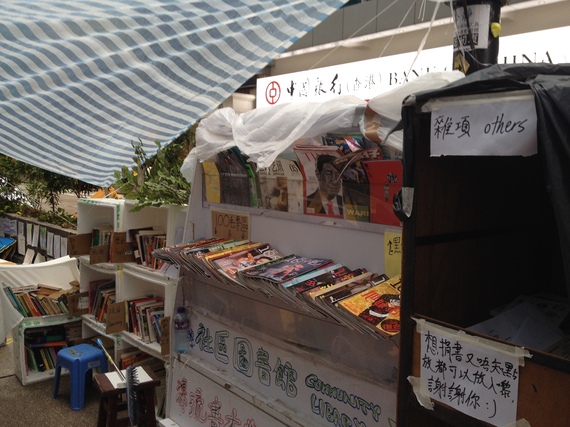In early November, after following the Hong Kong protests intently from afar, and writing or co-writing about them from the perspective of a longtime tracker of changes in the city and specialist in the history of Chinese social movements, I took a quick trip across the Pacific to see what was happening firsthand. In "Hong Kong Visions," a just published illustrated essay for the Los Angeles Review of Books, which is available in full here, I describe things I saw and heard in Admiralty (where the first photo shown below was taken), a centrally located part of the territory's financial district. It then concludes with some thoughts on Mong Kok, a neighborhood in a different part of the territory that is also a protest hub -- and where the second photograph below was taken. The following excerpt, from the end of the piece, focuses on contrasts between the two sites: Ever since I had arrived, people had told me not to leave without going to Mong Kok, a neighborhood in Kowloon, just across the harbor from Hong Kong Island proper, that was home to the territory's second largest Occupy zone. "You'll find it different," everyone said, varying from person to person in explaining just what the contrast with Admiralty would be.
When I finally made it to Mong Kok early on November 8, stopping off en route to Shenzhen, I realized that there were indeed many contrasts between it and Admiralty. The difference is due partly to geography: the encampment is on a regular street rather than a highway, which runs through a mixed residential and small business and shopping district rather than an area dominated by financial headquarters and government buildings. There was a more obvious law enforcement presence in the area, though I didn't see any of the violent incidents -- involving attacks on protesters by paid thugs, or by ordinary locals fed up with how long business in their area has been disrupted, or both -- which I had read about. (These scuffles usually happen in the evenings or under cover of darkness.) In addition, while there was plenty of artwork to admire in Mong Kok, it felt like a place where the focus was on things other than creativity, where economic issues were equally or even more important in bringing people to the street than electoral and free speech concerns -- though in Admiralty, too, the chasm between rich and poor was a concern expressed on many banners.
What I'll remember most about Mong Kok is a conversation I had with a pair of young people just before leaving the area. They had been sleeping at the site, not in a tent but on mattresses out in the open air, pushed together, making it clear they were a couple. I didn't quiz them closely about their lives, but got some basic facts. He said he was 20, she 17. He was at college training to be a social worker, and had been sleeping out since the movement began. She said she was still in high school, and didn't say how long she'd been at the site.
Our conversation -- carried out in a mixture of English and Mandarin, since I didn't speak Cantonese and they only knew a bit of my native tongue -- took place beside an open-air library, which the couple said they were helping to run. When I mentioned that I'd come to Mong Kok in part to see how the site differed from Admiralty, the boy, who had just woken up when I stopped to chat with them but ended up doing most of the talking, became animated. He told me that, unlike his girlfriend, he'd spent quite a bit of time across the harbor and would be happy to tell me how things on the Kowloon side were special.
He stressed that he had been impressed by what he saw at Admiralty, but felt more at home at the Mong Kok site. He thought that what was going on in Kowloon was especially admirable. The Mong Kok protests, he said, expressed the concerns and frustrations of many different sorts of people, including ones with little or no advanced education. Even though he was in school himself, he referred to the protests across the harbor being largely an expression of "student" ideals, invoking that category as one that applied primarily to those attending more elite institutions than the one he went to, which he described as a "tertiary" institution.
He got particularly enthusiastic when I mentioned that I had seen a couple of community libraries over in Admiralty that looked like the one he and his girlfriend were helping to run. "Yes," he said, "but this one's different. A lot of people in this neighborhood haven't used a library before, so setting this one up is trying to give them a sense of the value of a place devoted to books." In Admiralty, he suggested, the libraries were created so that protesters, while at the occupation, wouldn't have to give up activities they were used to, but in Mong Kok, it strove to get them to do something new.
Sometimes, the Admiralty side is seen as more of a utopian experiment, the Mong Kok encampment more concerned with pragmatic material issues. I saw posters that confirmed this idea of a divide, but his comment on libraries suggested a subtle twist to this. In Mong Kok, having books available that dealt with ideas about political rights (there was a section labeled with the characters for politics in Chinese, but in English saying "democracy"), as well as travel guides describing distant locales, handbooks for learning to program a computer, and novels by writers like Kafka, was an effort to open people's eyes to new vistas. The library in Mong Kok was as utopian a space as any I saw in Admiralty.
What sticks with me about the conversation I had in Mong Kok was that all three of us treated it as an opportunity to learn. Speaking to someone from the West seemed routine for the people I met in Admiralty, many of whom had doubtless traveled abroad, like the first student I met there. By contrast, I got the feeling that neither member of the Mong Kok couple had ever talked to an American before. And when I showed them a photo on my phone of my daughter, saying she was close to their age and spending a year teaching in Athens, their faces lit up, and the girl said she hoped someday she might be able to do something like that, to see at least part of Europe.
When I said I taught Chinese history and had done research on protest movements, they found this curious and asked me if anything I had studied helped me predict how the movement they were part of would end. I had to admit it didn't, but that I had certainly seen many things in Hong Kong that reminded me of past protests I had read about, including some mainland ones I discussed in books I'd written. Some things had also, I said, brought back memories of protests I had observed or taken part in, such as anti-Vietnam War demonstrations I had gone to with my family as a kid. What I wish I had said, but didn't think of at the time, was that they should understand that whether or not their struggle achieved any of its main, stated goals, it might end up later helping to inspire people in totally different settings to take risks to bring about change they believed in. For just as the Hong Kong protests, on both sides of the harbor, were adapting tactics and reworking slogans from many past struggles, they were enriching the local and international repertoire from which later generations of activists could choose.
After saying goodbye to these two likable youths and leaving the protest zone, I felt very glad that I'd made the visit to Mong Kok. I did, though, have one regret. During the evening I'd spent in Admiralty, on impulse I deposited a copy of the Taiwanese edition of my China in the 21st Century: What Everyone Needs to Know in one of that protest zone's libraries. I'm happy to think of the book sitting on the shelves there, but I left Kowloon feeling that it might have been even better placed in the small history section of the Mong Kok street library I had just visited.


